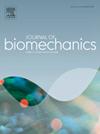脑瘫儿童在舒适和快速行走速度下的计划外步态终止策略。
IF 2.4
3区 医学
Q3 BIOPHYSICS
引用次数: 0
摘要
行走时避免碰撞是安全生活的必要条件,而较快的行走速度往往会增加碰撞风险。然而,脑瘫(CP)患者的步态终止策略(从舒适到较快的速度)仍未得到研究。本研究旨在分析脑瘫儿童与典型发育(TD)儿童在两种不同速度下的步态终止策略。参加研究的人员包括 10 名患有 CP 的儿童(平均年龄 12.5 岁;女性 5 名;平均身高 147.8 厘米;平均体重 41.7 千克)和 10 名患有 TD 的儿童(平均年龄 11.4 岁;女性 9 名;平均身高 142.0 厘米;平均体重 38.1 千克)。在 100 %(WS1)和 125 %(WS2)的舒适行走速度下,评估了行走速度对空间、力量和时间参数的影响。在 WS1(P = 0.006)和 WS2(P = 0.019)时,TD 组在地板上出现停止线后的第一步至对侧步前施加了更明显的制动力;然而,CP 组在第二步后(WS1:P = 0.026,WS2:P = 0.023)在前后(AP)方向施加了更强的制动力。此外,质心(COM)-压力中心(COP)在 AP 方向上的发散增加(P = 0.032),而在行走速度较快时,在内侧外侧(ML)方向上的发散减少(P = 0.036),这影响了 CP 组从 WS1 到 WS2 的运动特征。这种复杂的适应性,如独特的制动力和COM-COP发散的变化,表明步态干预应考虑独特的力,并采取动态平衡策略,以避免行走过程中的碰撞。本文章由计算机程序翻译,如有差异,请以英文原文为准。
Strategies for unplanned gait termination at comfortable and fast walking speeds in children with cerebral palsy
Collision avoidance while walking is necessary for safe living, and faster walking speeds tend to increase collision risk. However, gait termination strategies for patients with cerebral palsy (CP), from comfortable to faster speed, remain unexplored. This study aimed to analyze these strategies in children with CP compared to typically developing (TD) children at two different speeds. Study participants included 10 children with CP (mean age, 12.5; five females; mean height, 147.8 cm; mean weight, 41.7 kg) and 10 TD children (mean age, 11.4; nine females; mean height, 142.0 cm; mean weight, 38.1 kg). Effects of walking speed on spatial, force, and temporal parameters were assessed at 100 % (WS1) and 125 % (WS2) speeds of comfortable walking. The TD group exerted a more pronounced braking force at the first step after the stop line appeared on the floor until the contralateral step at both WS1 (P = 0.006) and WS2 (P = 0.019); however, the CP group exerted a more potent force after the second step (WS1: P = 0.026, WS2: P = 0.023) in the anterior-posterior (AP) direction. Additionally, an increase in the center of mass (COM)-center of pressure (COP) divergence in the AP direction (P = 0.032), which decreased in the mediolateral (ML) direction (P = 0.036) at faster walking speeds, influenced the kinetic characteristics of the CP group from WS1 to WS2. The complex adaptations, such as unique braking forces and changes in the COM-COP divergence, suggest that gait interventions should consider the distinctive forces and adopt dynamic balancing strategies to avoid collisions during walking.
求助全文
通过发布文献求助,成功后即可免费获取论文全文。
去求助
来源期刊

Journal of biomechanics
生物-工程:生物医学
CiteScore
5.10
自引率
4.20%
发文量
345
审稿时长
1 months
期刊介绍:
The Journal of Biomechanics publishes reports of original and substantial findings using the principles of mechanics to explore biological problems. Analytical, as well as experimental papers may be submitted, and the journal accepts original articles, surveys and perspective articles (usually by Editorial invitation only), book reviews and letters to the Editor. The criteria for acceptance of manuscripts include excellence, novelty, significance, clarity, conciseness and interest to the readership.
Papers published in the journal may cover a wide range of topics in biomechanics, including, but not limited to:
-Fundamental Topics - Biomechanics of the musculoskeletal, cardiovascular, and respiratory systems, mechanics of hard and soft tissues, biofluid mechanics, mechanics of prostheses and implant-tissue interfaces, mechanics of cells.
-Cardiovascular and Respiratory Biomechanics - Mechanics of blood-flow, air-flow, mechanics of the soft tissues, flow-tissue or flow-prosthesis interactions.
-Cell Biomechanics - Biomechanic analyses of cells, membranes and sub-cellular structures; the relationship of the mechanical environment to cell and tissue response.
-Dental Biomechanics - Design and analysis of dental tissues and prostheses, mechanics of chewing.
-Functional Tissue Engineering - The role of biomechanical factors in engineered tissue replacements and regenerative medicine.
-Injury Biomechanics - Mechanics of impact and trauma, dynamics of man-machine interaction.
-Molecular Biomechanics - Mechanical analyses of biomolecules.
-Orthopedic Biomechanics - Mechanics of fracture and fracture fixation, mechanics of implants and implant fixation, mechanics of bones and joints, wear of natural and artificial joints.
-Rehabilitation Biomechanics - Analyses of gait, mechanics of prosthetics and orthotics.
-Sports Biomechanics - Mechanical analyses of sports performance.
 求助内容:
求助内容: 应助结果提醒方式:
应助结果提醒方式:


